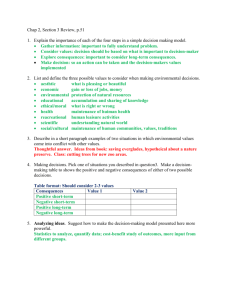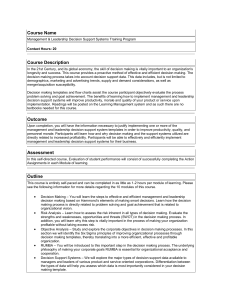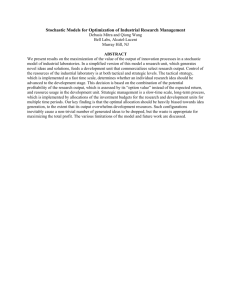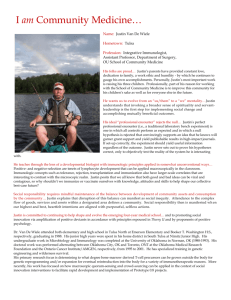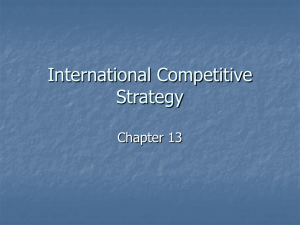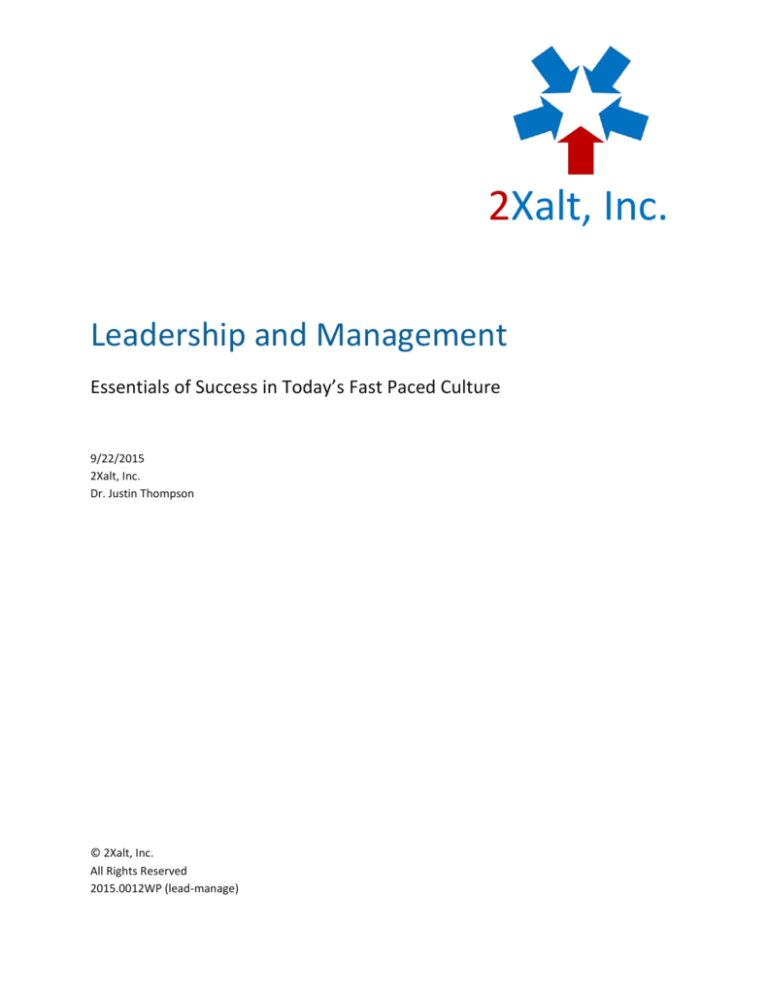
2Xalt, Inc.
Leadership and Management
Essentials of Success in Today’s Fast Paced Culture
9/22/2015
2Xalt, Inc.
Dr. Justin Thompson
© 2Xalt, Inc.
All Rights Reserved
2015.0012WP (lead-manage)
Leadership and Management
Essentials of Success in Today’s Fast Paced Culture
2Xalt, Inc.
Dr. Justin Thompson
CEO, 2Xalt Inc., Viera FL
Lead or Manage
It’s an age-old debate. Is there a tangible difference
between leadership and management? Are the
differences merely semantic? If there is a difference,
which is more important, and why?
In this article we’re going to review the meaning of
leadership, the meaning of management, and discuss
why we should care.
In many ways the differences can be subtle, yet they
are quite distinct. This distinction can be a matter of
life or death for organizations that don’t know the
difference – and end up forcing, or encouraging,
people in to the wrong roles.
It’s become trendy recently to describe management
in a negative light, and suggest that what we really
need is leadership. We most certainly do need
leadership, but management is equally as essential.
Leadership without management will lose traction.
Similarly, management without leadership will get
left behind by changing market landscapes and
operating environments.
What’s the Difference?
The
differences
between
leadership
and
management are very real. We’re going to look at the
differences in focus, orientation, and the key
activities of each discipline.
Focus
Leadership and management are focused on different
areas of any organizational plan. Leadership is highly
focused on the long-term. Leadership is about vision.
Of course leaders care about the short-term. Some of
their time will be devoted to immediate results, yet
Dr. Justin Thompson
22 Sep 2015
their primary focus remains on the long-term vision.
Leaders care about today, yet are more focused on
the future. In a leadership mindset ‘short term’ refers
to this year – or maybe even next year. Leaders think
in terms of vision, and exude a calm confidence and
passion to realize the abundant possibilities that the
future holds.
Management, on the other hand, is focused on the
short-term. Good managers care about the long-term
results, but most of a manager’s day-to-day energy is
spent on today’s results. In a management mindset
‘this year’ is the long-term, while short-term is more
likely to refer to next week, or next month at the
latest. Manager’s think in terms of systems and
processes, and the immediate accomplishment of
meaningful results.
Neither discipline is inherently good, or bad. Both are
essential components to success. Leadership needs
to be focused on the long-term, but can’t afford to do
this without good managers to delegate short-term
results too.
Orientation
Leaders are strong strategic thinkers. Their primary
thought processes are concerned with components of
strategy: purpose, principle, and passion. Passion, as
described in the upcoming book STAR Performance,
consists of an inspiring vision, clarifying mission, and
strategic objectives and initiatives. A leadership
orientation is focused on the mission and driving
long-term results towards the objectives of that
mission.
Managers are strong tactical thinkers with thought
processes concerned with the components of a
tactical
plan:
preparation,
planning,
and
prioritization. A management orientation is focused
1 of 4
Developing Leadership and Management
Essentials of Success in Today’s Fast Paced Culture
2Xalt, Inc.
on promoting efficiency in day-to-day operations that
result in a high degree of predictability in the shortterm. This tactical planning involves concern for
goals, programs and operations.
A leader promotes alignment between strategy and
tactics. They will ensure that the tactical programs,
operations, and goals are supportive of the strategic
mission, objectives, and initiatives that define the
vision.
A manager promotes alignment with systems and the
tactical plan. They will ensure effective execution of
the tactical programs, operations, and goals.
Activities
Leadership activities and management activities vary
strongly.
Leadership is about capitalizing on
opportunities. It requires inspiring the team with a
strong vision, developing an adaptive culture, and
aligning the people and the organization with the
vision. The focus is on vision, and the activities
include equipping the team with the people needed
to drive the vision to reality. In the book Good to
Great Jim Collins states, “Great vision without great
people is irrelevant.”1 He’s absolutely right, and this
is why, in addition to vision, team building and
alignment is an essential task of leadership. To drive
this point consider this statement by Rudolf Giuliani
from his book, Leadership, “A leader must have
confidence in his own decision-making about
people.”2
The leader creates the vision, and
establishes the team to make the vision become
reality.
Management activities are about controlling
processes and programs, and about solving problems.
Management activities are heavily occupied with dayto-day details, promoting efficiency, driving quality,
and ensuring predictability of results. John Kotter
says that management “produces a degree of
predictability and order and has the potential to
produce the short-term results expected by various
stakeholders.”3 This potential for short-term results
Dr. Justin Thompson
is critical. It enables leadership to reach long term
vision, and thus the two must proceed hand-in-hand.
Reality Check
The reality of organizational life is that both
leadership and management are essential. The best
leadership in the world will never achieve its vision
without proper management of short-term results.
Likewise, the benefits of great management will be
short lived without a vision for the future.
Regardless of role, a mix of leadership and
management skills are required to excel. Front-line
managers must have strong management skills in
order to maintain productivity and efficiency, yet
leadership abilities are essential to adapting the team
to the vision and making the front-line team impactful
contributors to long-term success. This is a must in
today’s fast-past environment. CEOs must be great
leaders with visionary approaches if they are to
promote long-term growth. Yet a CEO that lacks
management skills will have great difficulty
empowering the team and ensuring the short-term
success that is essential to long-term plans.
In our fast-paced world we must achieve fast paced
organizations, with powerful visions for the future
that can be rapidly adjusted when conditions change
(because they will change). This means information
must flow rapidly, data collection must happen real
time, process controls must be adjusted on the fly,
and everyone on the team must know and
understand the vision AND how they will contribute
directly to its accomplishment. Everyone on the team
must be part manager, and part leader.
The balance between leadership and management
skills required will vary from one role to another, yet
we must strive to develop both leadership and
management skills for everyone on the team. As we
do so we will see some people lean more towards
one, or the other – and this leaning may change over
time, for any one individual. Lifelong learning is
2 of 4
Developing Leadership and Management
Essentials of Success in Today’s Fast Paced Culture
2Xalt, Inc.
essential for building both management and
leadership skills. One is born with certain innate
abilities, and activating these abilities is only possible
through learning and experiencing. In this way, I do
not believe that leaders are born. Instead, individuals
are born with certain abilities, and strong leadership
is drawn out by sharpening and applying these natural
abilities through experience and learning. The same
is true for managers. One might be born with a
natural ability to focus on details, yet becoming a
strong manager will require training and experience
to learn what to look for, and what to do with it when
you find it.
As individuals we must never forget this, and always
strive to grow and learn. As organizations we must
promote, encourage, and enable lifelong learning.
Doing so will ensure that our teams are filled with
people that are continually trying new things,
adapting to changing environments, and creatively
providing more for the organization than any one
person could have imagined.
Leadership
Visionary
Abundant possibilities of
the future
Big Picture
Strong Strategic Thinker
Purpose, Principle,
Passion
Mission
Initiatives
Objectives
and
Alignment
Capitalize on opportunities
Inspire the team
Aligning people with vision
Aligning
organizational
structure with vision
Management
Systems & processes
focus
Immediate
accomplishment
meaningful results
Details
About the Author
Dr. Justin Thompson is a visionary
leader with a passion for
intentional team building and
mentoring.
His desire is to
influence people to be confident
individuals that are a harmonious
part of a thriving team or
organization. He is the founder and
CEO of 2Xalt, Inc., an organization created with the
purpose to exalt the performance of individuals,
teams and organizations. He has developed the
S.T.A.R. model for personal and organizational
excellence. This model unites planning with doing,
and is described in his upcoming book, STAR
Performance, being published by Westbow Press.
of
Strong Tactical Thinker
Preparation, Planning, and
Prioritization
Programs
Operations
Goals
Controlling
believe in the value of vision, and aren’t afraid to take
ownership of their part in the transforming of that
vision into reality. Efficiency will improve at a much
faster pace. Problems will be solved in record time.
Short term results will improve, and long term visions
will be accomplished.
Process controls
Directing programs
Developing operations
Problem solving
Driving efficiency & quality
Dr. Thompson has nearly two decades of experience
in technology businesses holding roles of increasing
responsibility from the manufacturing floor to the Csuite. In every role, regardless of org chart hierarchy,
Justin has enjoyed the impact of inspiring others and
helping them to imagine the possibilities of what they
could accomplish if they work in unity of purpose
towards common goals and objectives.
The skills needed for leadership and the skills needed
for management are both learnable skills. Promoting
the learning of both leadership and management
skills within our organizations will empower the
entire organization to be forward thinking people that
Dr. Justin Thompson
3 of 4
Developing Leadership and Management
Essentials of Success in Today’s Fast Paced Culture
2Xalt, Inc.
1
2
Collins, Jim. “Good To Great.” Harper. 2001. Pg. 42.
Giuliani, Rudolf W. “Leadership.” Hyperion. NY. 2002. Pg. 35.
Dr. Justin Thompson
3
Kotter, John P. “Leading Change.” HBR Press. 2012. Pg. 29
4 of 4

